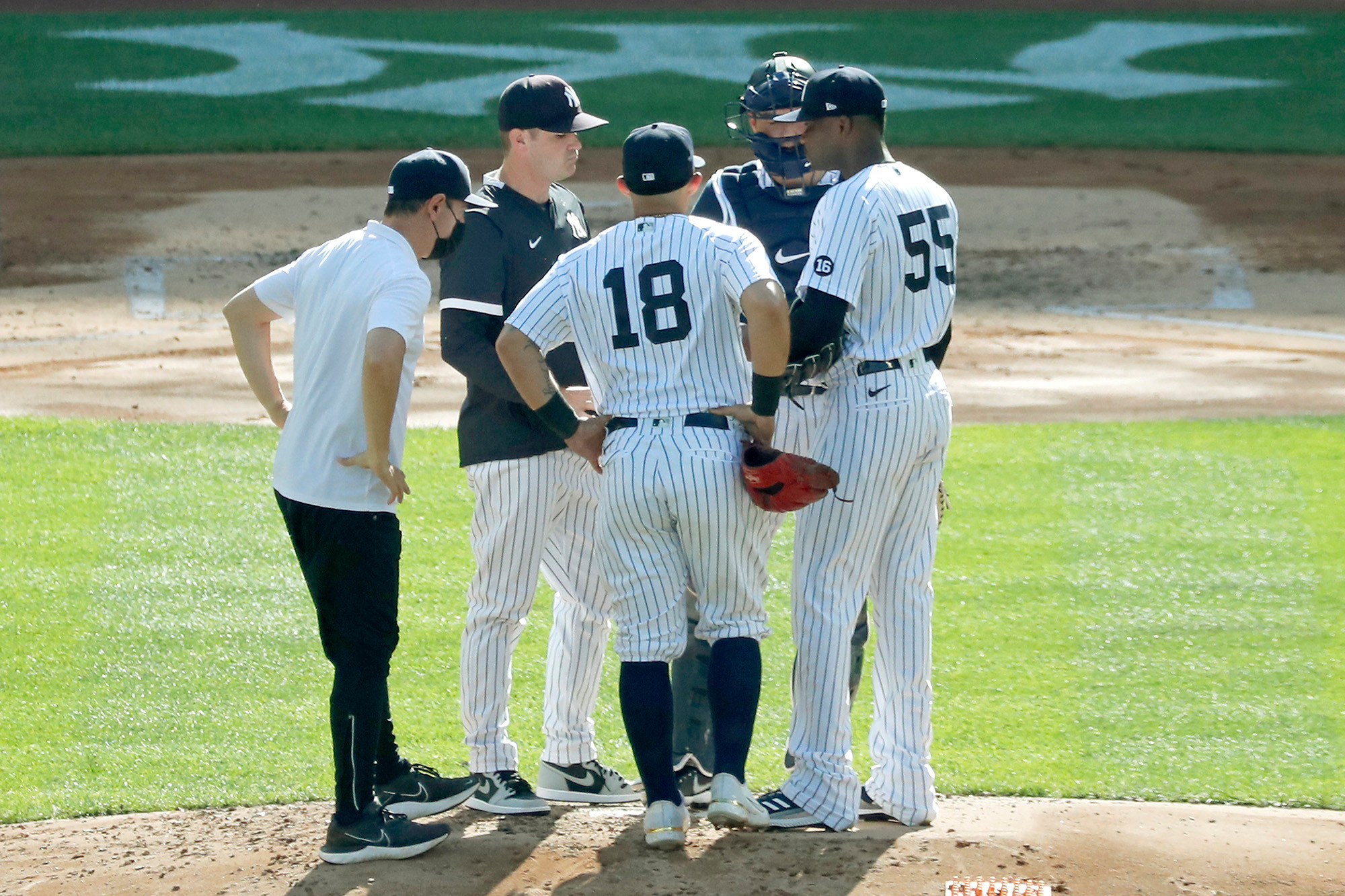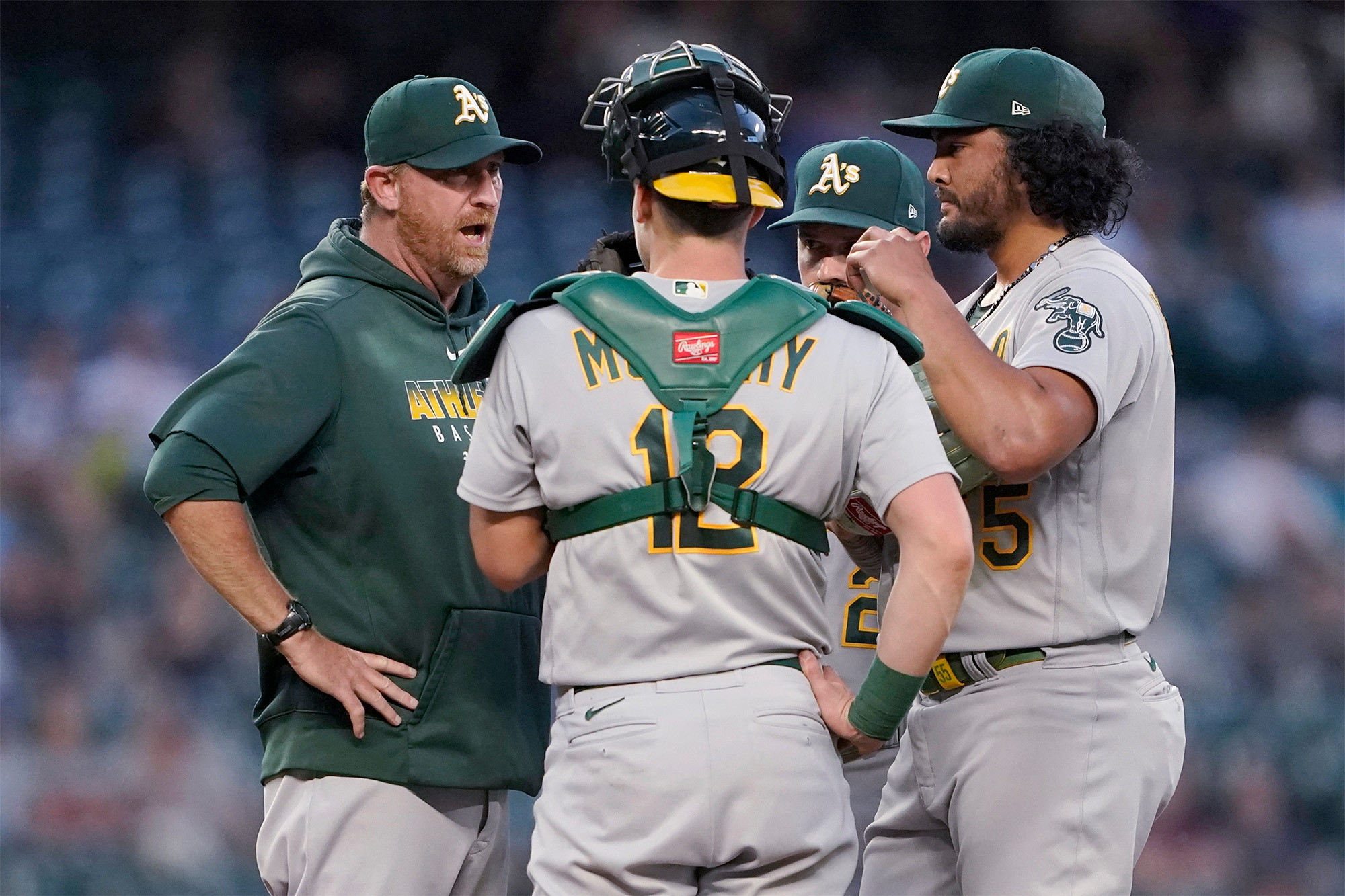More On: hardball
Cubs’ selloff may change how we view the Yankees: Sherman
Making sense of Yankees’ underwhelming draft history: Sherman
Shohei Ohtani, plenty of Mets and Yankees take midseason awards: Sherman
Yankees have to seriously consider these potential trades: Sherman
How to solve MLB’s maddening mound visit problem: Sherman
Mound visits have been a pet peeve of mine for years.
More from:
Joel Sherman

Aaron Boone's Yankees hope springs eternal but summer's here: Sherman
MLB must put a stop to cheating substance epidemic: Sherman
Yankees' stubbornness taking its toll: Sherman
Aaron Hicks, Luis Severino contracts are Yankees disasters: Sherman
Yankees can’t hide from AL East reality any longer: Sherman
I want to discuss mound visits. I know, MLB has much larger issues than mound visits. But let’s see if I can make a case where these fit into the larger context of what obsesses the leadership of the sport these days, notably pace of play and lack of on-field action — issues that often are intertwined.
Mound visits are on my mind again because the Rays just were at Yankee Stadium for four games, and if my calculations are correct — though teams are allowed just six visits per game — somehow Tampa Bay pitching coach Kyle Snyder went out 41 times for a total of 1 hour and 6 minutes.
And though I would not accuse the Yankees of copycat envy of the small-market genius persistently demonstrated by the Rays, suddenly in these four games I saw their pitching coach, Matt Blake, more than in any other four series combined.
Mound visits have been a pet peeve of mine for years and, generally, here is why: If we were charged with creating the sport of baseball right now and the starting place were the basics such as three outs a half-inning, nine innings, four balls, three strikes, 90 feet to first base, etc., then our job really would be the finer points. And someone within this committee stood up and said, “Here is my idea, at least six times a game — during actual action within an inning — a coach on each team can walk (really slowly at times) to the mound and provide counsel to a pitcher until an umpire walks (really slowly at times) to the mound to break it up, at which point the coach can continue to talk for just a bit longer anyway.”
If that were proposed, how quickly would we throw that person off the committee? Especially now, when viewers’ attention spans are shorter and the games are way too long. Aside from perhaps the Yule Log and test patterns, is there anything more boring that we could put in front of fans than a middle-aged coach slowly walking to the mound, conversation ensuing, a middle-aged umpire walking to the mound to break it up?
Crazy, right? Except this is permitted up to 12 times combined for two teams within a nine-inning game. The Rays, always looking for edges of any type, seem to use an on-the-book rule well, especially at critical junctures when Snyder comes out to emphasize what to do at that pressured moment.

So here is my compromise (and, yes, I have recommended versions of this previously): Each team is given five timeouts for nine innings to use for an instant replay challenge or to allow a catcher, manager or pitching coach to make a mound visit. But you only get five (I would drop it to four or even three as clubs get used to this over the years). Here is why:
It would force teams to be more judicious about when they use challenges or mound visits. Both of these often slow down the game unnecessarily. So after that bang-bang play with two outs and no one on in the first inning, you might want to hold your challenge (and timeout) for a meatier situation later. You want to visit your pitcher in the fifth inning to go over how to pitch to a pinch-hitter you discussed five hours earlier in a pitcher strategy meeting, sure, but then you might not have it for the eighth or ninth inning. I believe adding strategy and in-game decision-making pressure on managers would be a positive for the game, while removing the negative of all the stoppages.
I also would force managers to decide about replay within 10 seconds of a play’s conclusion. So the manager holding up his hand (more boring, non-action moments) to tell the umpire to wait until his bench coach gets a call from his video replay coordinator to decide whether to challenge a play would be eliminated — along with the video replay coordinator. It would be up to the manager to decide instantaneously whether the play was important enough and egregiously wrong enough (the reason replay was put in) to challenge. Again, deep breath, who thinks it is a good idea to have the hand up, phone call, wait, challenge-or-not sequence as a regular part of games?

But in exchange for this, a manager could challenge anything that occurs except ball-strike calls (perhaps we are close to robot umps and more uniformity there). So all those instances that come up in a game that are not covered by replay — such as out of baseline, interference and obstruction that make folks yell, ”Why is that not covered?” — well, now they are. But it would cost you a timeout to check on it.
The sport is looking for ways to increase offense, and there is a universal belief that nearly every legal and illegal advancement in the past decade has favored the pitcher. So can we stop helping a pitcher in the middle of an inning with counsel or a breather? Can you imagine any other sport allowing this without a timeout? An NFL defense brings in a new free safety on third down and an assistant coach can just wander out to the huddle and tell the quarterback the strengths and weaknesses of the guy? An NBA free-throw shooter misses his first free throw in a big spot and looks rattled, and his shooting coach sashays out to give him a mental break and advice? Ludicrous, right?
So beyond tradition, why are we still allowing this in baseball? How about the best-prepared and smartest teams gain an advantage? Those that retain information from spring training through all the pre-series and pregame pitching and hitting meetings would gain an edge. Pitchers who are able to slow down the game in times of trouble without the assistance of a coach also would get an edge. Catchers and pitchers have between innings for discussions, they have cards in their hats to change signs with runners on base mid-inning. If they are too daft to be able to do this without a meeting on the mound, then it costs them a timeout or it costs them a disadvantage against the hitter.
And one more item: Pitching changes are made from the dugout. Again, if we were starting the sport from scratch, why would we let another middle-aged person walk deliberately to the mound, have a discussion, with often the middle-aged ump being forced to walk out to demand resolution. Managers are doing this regularly to stall because they were too slow in getting a reliever ready. Once more, the best-prepared manager would get an edge. If you can’t anticipate the game, your team gets dinged for it (probably helping offense).
Or you could use a timeout. But you only have five. So use them wisely.
This story originally appeared on: NyPost - Author:Joel Sherman














